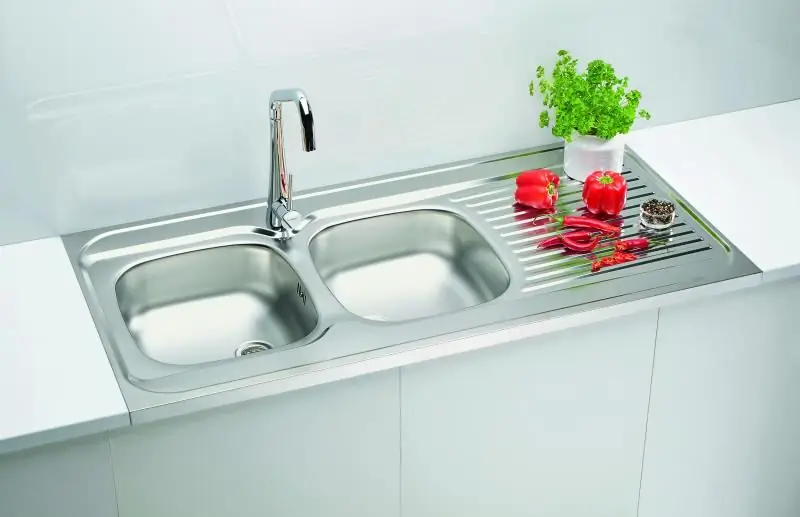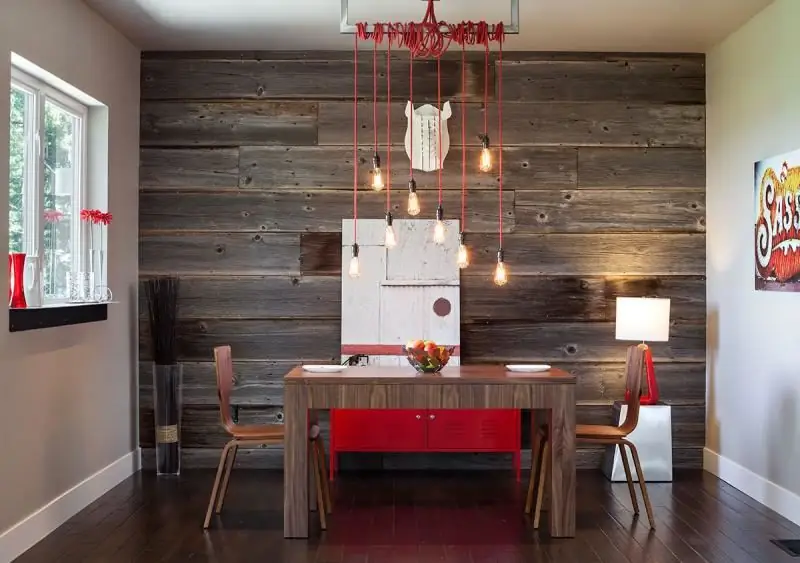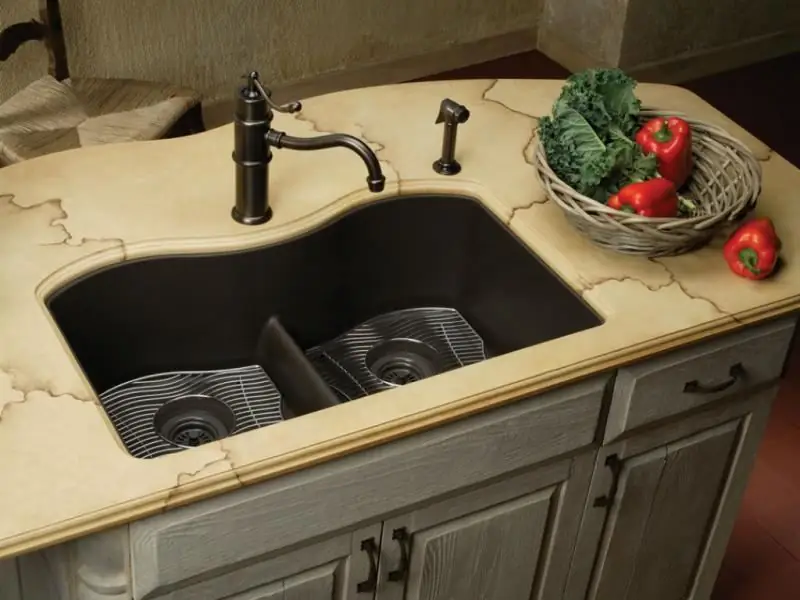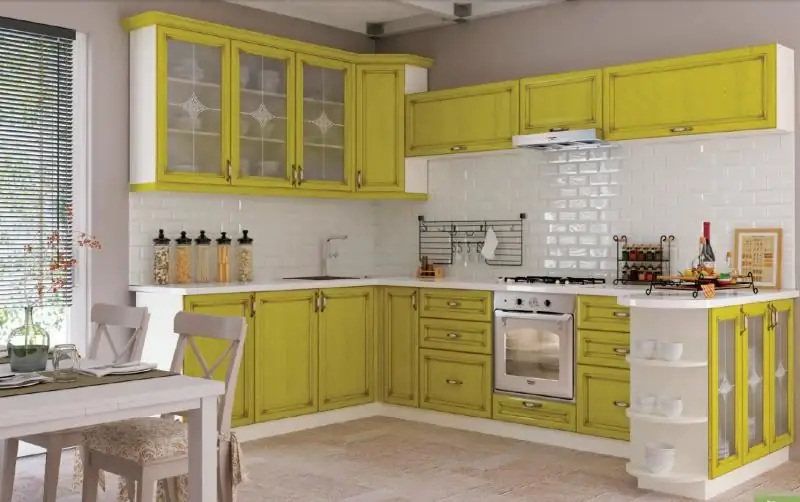
Table of contents:
- Author Bailey Albertson [email protected].
- Public 2023-12-17 12:53.
- Last modified 2025-06-01 07:32.
Overhead kitchen sink: design features and selection criteria

Until recently, surface-mounted sinks were the most common, popular and affordable. Then they were replaced by mortise and integrated sinks, but in some cases, the use of an overhead structure is still justified and necessary.
Content
-
1 Overhead sinks: positive and negative sides
1.1 Video: choosing a kitchen sink
-
2 Recommendations for choosing a surface-mounted kitchen sink
- 2.1 Choice of shape and size
- 2.2 Material selection
- 2.3 Manufacturer selection
-
3 Installation features
- 3.1 Video: mounting the surface-mounted sink on the brackets
- 3.2 Video: Installing Franke Surface Sink
- 4 Caring for your sink
Overhead sinks: positive and negative sides
Overhead kitchen sinks are most often used in inexpensive economy class headsets, when furniture is assembled from separate sections and does not represent a single integral structure. Such a sink is superimposed on a standard lower cabinet and is fixed to it using the fasteners included in the kit.

Overhead sinks are often used in inexpensive, free-range kitchen units when all cabinets are sold separately.

The overhead sink is simply superimposed on the lower cabinet
Surface-mounted kitchen sinks have a number of advantages:
- low cost;
- ease of installation, which is easy to do with your own hands;
- multifunctionality - there are models with an additional wing, which can be used as a working area;
- uncomplicated care.

The main advantage of overhead sinks is the affordable price, so they are most often installed on inexpensive headsets.
The disadvantages of such designs include:
- noise at work;
- low mechanical resistance;
- lean design;
- inability to fix the mixer well.
Video: choosing a kitchen sink
Recommendations for choosing an overhead kitchen sink
When deciding whether to buy a sink consignment, you should be guided by several important points.
Choice of shape and size
The overhead kitchen sink is rectangular or square with slightly rounded corners. The side adjacent to the wall is always folded upwards to prevent water from entering the wash cabinet. The sides on the other three sides are bent downwards and are used for fastening to the pedestal.

The overhead sink is always square or rectangular
The size range is large enough:
-
width 50 or 60 cm;

Sink 50 cm The smallest surface sink is 50 cm wide
-
length from 40 to 150 cm.

Sink 150 cm The dimensions of the largest sink can be up to 150 cm
The most commonly used (length / width):
- 50 * 50 cm;
- 50 * 60 cm;
- 60 * 60 cm;
- 80 * 60 cm;
- 80 * 50 cm.

The most popular is considered to be an overhead sink measuring 60 * 60 cm.
The bowl has a depth of 16 to 19 cm. Their quantity and orientation may vary:
-
with one large container located in the center;

Sink with one bowl The overhead sink can have one bowl
-
with several bowls of smaller volume (usually two);

Sink with two bowls The overhead sink can have two bowls of the same size
-
with one bowl and an additional wing-platform, where you can put washed dishes, vegetables, etc.

Overhead sink with drainer The overhead sink can have a drainer, which is convenient to use for drying dishes
Overhead sinks are not reversible (unlike most inset sinks), that is, they are performed in the right and left versions. This is indicated by marking:
- R - bowl on the right;
- L - bowl on the left.

Overhead sinks are also corner
Material selection
Most washbasins are made of thin (0.5-0.8 mm) sheet steel. The surface of the product is glossy, matte and with a decor finish. Glossy sinks look the most impressive, but are difficult to maintain. Brushed and decorated steel looks simpler, but stains and scratches on it are not so striking.

On the decorated stainless steel, dirt and scratches are less noticeable

Elite overhead sinks are made of ceramics or composite materials
When choosing an overhead sink, you need to focus on the thickness of the steel. The larger it is, the more durable the product and, accordingly, more expensive. Thicker stainless steel makes less noise when a jet of water hits it and is not so vulnerable to mechanical stress. On such a sink, the mixer is securely fixed (does not dangle).

On a thin steel sink, the mixer will dangle
Manufacturer's choice
In stores you can find overhead sinks of the following brands:
-
Melana. Russian manufacturer based in Chelyabinsk. All sinks are made of 201 grade steel - a mixture of chromium and nickel, which is designed for use in the food industry, that is, it does not come into contact with food acids, with an increased level of hardness and corrosion resistance. Service life not less than 25 years;

Melana sink Melana sinks are made of quality stainless steel
-
Eurodomo. A subsidiary of the famous Swiss company Franke, the world leader in the production of stainless steel kitchen sinks, located in St. Petersburg. The sinks are made of stainless steel AISI 304. The warranty period is 10 years;

Washing Eurodomo Eurodomo sinks are available in glossy and matt surfaces
-
Sinklight. Domestic manufacturer with production bases in China. Food grade 201 stainless steel is used for the manufacture of sinks;

Sinklight sink Sinklight sinks come in a variety of configurations
-
Blanco. The most famous German manufacturer of premium kitchen accessories (sinks, mixers, etc.) made of stainless steel, silgranite composite and ceramics.

Blanco sink Blanco manufactures premium sinks
When choosing a kitchen sink, I would advise you not to be seduced by the low cost of Chinese products, because the quality of the steel from which they are made leaves much to be desired. It is unclear if it is food grade. It is preferable to choose domestic manufacturers that guarantee high quality products and a long service life.

On sale you can find sinks of other brands, for example, Ukinox
Installation features
You can install an overhead sink with your own hands, without the help of specialists. This is done like this:
- First, assemble a supporting furniture cabinet of the appropriate size.
-
The sink is taken out of the package, placed on the cabinet and the mounting holes are marked with a pencil or marker.

Markup First you need to do the markup
-
With the help of self-tapping screws, plastic brackets are screwed, which are corners with a toothed slot (sometimes they are not included in the kit and you need to buy them separately).

Brackets Sometimes you have to buy brackets for mounting a sink separately
-
For waterproofing, the bottom edge of the sink and the ends of the side walls of the cabinet are coated with silicone sealant.

Sealant treatment The cabinet and the sink are treated with a sealant
- The sink is placed on the cabinet so that the sides fall into the grooves of the fasteners.
-
By sliding the plastic mount forward along the toothed slot, the sink is drawn to the basket.

Surface sink installation diagram Installing an overhead sink is very easy
- The excess squeezed out silicone is immediately removed with a wet cloth or sponge.

It is better to attach a mixer, siphon, etc. to the sink in advance.
Video: installation of an overhead sink on brackets
Video: Installing the Franke surface-mounted sink
Car wash
Stainless steel kitchen sinks need constant maintenance, otherwise they quickly lose their attractive appearance. After each use, remove debris and food debris from the strainer covering the drain hole, rinse the sink with warm water and wipe it dry.

Wipe the sink dry after each use.
At least once every 7-10 days, the surface is washed with the help of specialized stainless steel care products (liquids, sprays, gels).

There are specialized products for the care of stainless steel

Do not rub a stainless steel sink with hard brushes and abrasive compounds
I treat minor abrasions and scratches on my stainless steel sink with specialized protective polishing agents, which create a thin protective film. In this case, the sink becomes less dirty, after use it is enough to wipe it with a dry cloth.
Overhead sinks are practical and affordable. You can pick up a very good product with an optimal price / quality ratio that will serve for many years.
Recommended:
Wall Decor In The Kitchen: Design Ideas, Photos, Advice On Choosing Materials, Decoration Near The Table And Work Area

When and how you can decorate the walls in the kitchen. Features of the use of different techniques and materials for decoration, as well as the choice of decor items
Double Sink For The Kitchen: Purpose, Features And Dimensions, Installation Nuances

What are double kitchen sinks and what you should look for when buying. How to install a sink yourself
Kitchen Design With A Bar Counter Combined With A Living Room: Interior Design Features, Photo Ideas

What is taken into account when designing a kitchen-living room with a bar counter, as well as how to choose furniture and lighting. Choosing a kitchen-living room style, decor options and shades
Square Kitchen Design: Layout Features And Design Options, Photos Of Original Ideas

Square-shaped kitchen layout options, choice of design style and design rules. Decor features, selection of shades and lighting for a square kitchen
Kitchen With Patina On The Kitchen Set And Furniture: What It Is, Interior Design Features, Photo

What is patina. Advantages and disadvantages of patination. Kitchen design with patina: colors, styles and interior features
